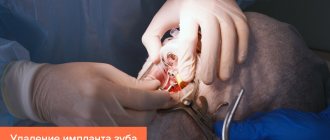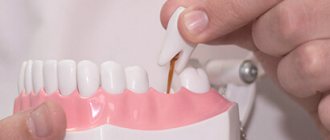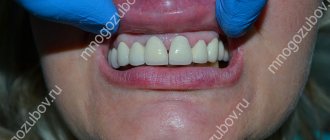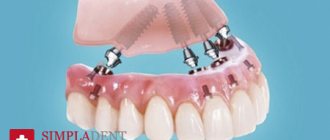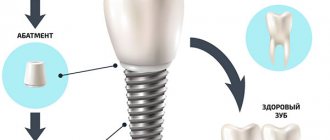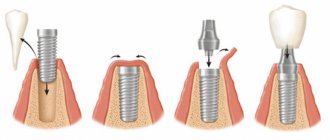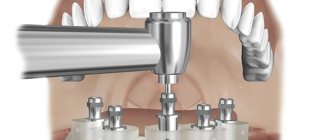Dental implantation is the replacement of a missing tooth with an artificial one by inserting a titanium screw into the jawbone. This is the most physiological and aesthetic way to restore the full functionality of the dentition among all the methods of dental prosthetics available today.
Modern implantation protocols make this procedure absolutely safe, predictable and most effective. However, even a flawlessly performed operation does not mean 100 successes. Although the survival rate of implants reaches 98-99%, in almost 2% of cases the titanium root is rejected.
How long does it take for an implant to take root and when can it fail?
It takes up to 6 months for the implant to take root securely in the bone. The engraftment time depends on various factors, among which the site of installation of the titanium root should be specifically highlighted:
- An implant in the upper jaw takes 5-6 months to take root on average, since the bone in this area is characterized by lower density and weaker blood supply.
- The osseointegration of an artificial root installed in the lower jaw takes 3-4 months.
Rejection of a titanium structure can occur either a couple of days after its installation or after several months or years. It happens that the rejection process is asymptomatic, but more often, such a complication manifests itself very clearly.
How does an implant normally take root?
After installation of the implant, a period of osseointegration with the bone tissue of the jaw begins, which goes through three stages:
- Initial (3-4 weeks) Spongy bone tissue begins to form around the implanted implant. Until it is mature and has a low density, it is better to avoid chewing loads so as not to disturb the position of the implant in the jaw.
- Formation of mature bone (16-18 weeks) Spongy tissue is replaced by denser (lamellar) tissue. Completely fills the space between the implant and the jawbone. Provides stability sufficient to load the implant with a prosthetic structure.
- Final (up to one and a half years) The implant finally fuses with the bone tissue. After completion of this period, the success of implantation is determined. If the patient follows the rules of care and use, nothing should happen to the artificial root.
After engraftment, the implant becomes a full-fledged part of the dental system and can last a lifetime .
Signs of dental implant failure:
- Mobility of a titanium rod during immediate implantation.
- Continuous postoperative bleeding (longer than 2-4 days).
- Discharge of pus from the surgical wound 1-2 weeks after the intervention.
- Severe pain at the implantation site, which intensifies with pressure. Painkillers don't help.
- Swelling, edema, inflammation of the gum adjacent to the implant, change in its color (redness, cyanosis), proliferation of granulations, formation of ulcers or fistula.
Signs and symptoms of dental implant failure
Implantation involves regular visits to the dentist, who monitors the process of osseointegration and identifies complications. The first visit should take place a few days after the operation. If you neglect a medical examination and do not consult a doctor if pain or swelling occurs, then the risks of complications increase.
It is not difficult to understand that problems have arisen, since the symptoms are pronounced. Signs of titanium rod rejection may appear not only during rehabilitation, but also later. Symptoms are similar in different periods:
- swelling, redness of the mucous membranes for several days (more than 5 days after surgery);
- painful sensations in the area of the installed titanium rod, especially when pressing on the gums;
- increased body temperature;
- bad breath;
- rod mobility;
- purulent discharge from under the gums.
If you have at least a few symptoms, you should consult a doctor. If conservative treatment is not possible, then removal of the titanium root is indicated.
Expert opinion
Igor Yurievich Malinovsky
Maxillofacial surgeon, implantologist
Experience: more than 11 years
Dental implant failure is a very rare occurrence. Provided that the implantation is carried out with high quality and the implants are correctly selected, everything ends successfully, and the patient uses new teeth for the rest of his life. If, due to violations of rehabilitation rules, accidental injury or other reasons, the implant is rejected, do not despair. In most cases, it is possible to install a new artificial root of larger diameter in its place after eliminating the pathological process.
What doctor mistakes lead to peri-implantitis?
At the first stage, when preparation for treatment and direct installation of implants is carried out, the positive outcome of implantation depends 90% on the doctor. After this, most of the responsibility passes to the shoulders of the patient himself.
- errors at the diagnostic stage: implantation only on the basis of OPTG (panoramic image) data without the use of three-dimensional computed tomography (CT); implantation without prior assessment of the patient’s health status,
- Chronic diseases are not excluded and are not taken into account, as well as certain conditions: pregnancy, menopause and menstruation in women, diabetes mellitus, active smoking and drinking alcohol, periodontitis and periodontal disease, ENT pathologies, poorly treated teeth in the oral cavity,
- errors at the treatment planning stage, for example, incorrectly chosen place for implants, too thin bone, too close to natural teeth,
- errors at the stage of implant installation: violation of sterility, damage to the coating of implants, saliva getting into the hole, use of non-original products, etc.,
- errors at the prosthetic stage: overloading of all or some of the implants in the complex, cement getting into the cavity, incorrect design of the prosthesis, restoration of only one jaw, etc.
Read more about all the mistakes that can be made during implantation in our separate material >>>
“The case of each patient in our clinic is reviewed by several doctors. This is necessarily a maxillofacial surgeon-implantologist, as well as an orthopedist. Already at the initial stage we evaluate every nuance, consider every detail. It is very important to us that the patient receives not only a beautiful smile, but also teeth that can be used to eat without pain.”
Chorny Stanislav Vladimirovich. orthopedic dentist, more than 20 years of experience
Non-original components mean a risk of implant rejection! We use only original implants, abutments and other superstructures that are tightly connected without joints or micro-gaps. As a whole, they passed a quality test directly at the factory - the manufacturer guarantees that they will function fully for many years.
sign up now
Why do dental implants fail?
There are three periods of artificial root rejection:
- From the moment of implantation to dentures.
- Within 2 years after the intervention
- In 2-3 years or more.
If the implants do not take root, the reasons for this complication are as follows:
- Infectious and inflammatory process around the titanium root (peri-implantitis).
- Insufficient volume or poor quality of the jawbone.
- Trauma to the jaw or excessive chewing loads on the recently implanted implant, which led to its displacement and the development of inflammation.
- An allergic reaction to titanium or its alloy (the material from which the artificial root is made).
- Incorrectly selected implant model, errors in its design or design.
- Individual characteristics of the body - exacerbation of a systemic disease, anomalies in the structure of the dental system or bone structures.
- Failure to comply with the recommendations of the implantologist means lack of oral hygiene, bad habits, and dietary errors.
- Errors during surgery - insufficient qualifications of the doctor, the use of implants and consumables of poor quality, non-compliance with the implantation protocol, incorrect installation of the screw structure, etc.
Regardless of what caused the signs of rejection, you should immediately consult a doctor.
Is it possible to save an implant if rejection symptoms have already appeared?
If signs of implant rejection appear, you must immediately contact the clinic . The sooner measures are taken, the greater the chance of saving the new tooth.
The measures taken are determined by the doctor based on an examination of the installed implant and X-ray data.
Treatment tactics are individual in each clinical case. Here are some example diagrams:
- Inflammation at the initial stage affects the surrounding soft tissues. The plug screw is unscrewed from the implant, the gums in the area of contact with the implant and the plug are cleaned and disinfected. The screw is returned to its place and sutured.
- The inflammation affects the deeper periodontal tissues, but does not go beyond them. The gums are opened, the affected area is cleaned and disinfected, and a course of antibiotic therapy is prescribed.
- The infection spreads to the bone tissue. The degree of bone destruction is revealed. After removing necrotic tissue and stopping the inflammatory process, bone grafting is performed (directed bone regeneration using protective membranes).
- Serious tissue damage is accompanied by bone loss. A decision is made to remove the structure. The bone tissue is cleaned, and after eliminating the inflammatory process, it is restored using one of the methods of osteoplasty. Next, the question of the possibility of re-implantation is decided.
What to do if inflammation begins under the implant?
If inflammation begins around the artificial structure, treatment consists of eliminating the cause that caused it - removing bacterial plaque, improving the quality of oral hygiene, drug therapy, including antibiotics. If the inflammatory process is localized only in the gum area and has not led to the destruction of bone tissue around the implant, there is a 100% chance of eliminating the problem and preserving the structure. With the development of peri-implantitis, severe mobility of the titanium rod or its breakage, the structure is removed and anti-inflammatory treatment is carried out.
The final decision is made by the implantologist after appropriate diagnostic measures. During the period of restorative treatment, the patient is fitted with a temporary denture, which allows maintaining the functionality and aesthetics of the dentition.
Problems after implantation
After unsuccessful installation of implants, diseases such as mucositis and peri-implantitis may develop. They are characterized by periodontal inflammation in the area of the implants. These diseases are similar in symptoms to periodontitis and gingivitis, but differ in the nature of their course.
Mucositis manifests itself as inflammation of the mucous membranes in the area of the implant, while there are no signs of bone loss. With peri-implantitis, an inflammatory process occurs in the soft tissues also in the area of the implant, but it is accompanied by bone resorption. Diagnosis is made using probing of the gum pockets and x-rays. Mucositis is a less serious disease, its treatment is faster and easier, including cleaning the gum pockets and treating them with antiseptics.
Peri-implantitis is a more complex disease that develops against the background of poor implant healing. Inflammation starting in the oral cortex can lead to bone loss. It occurs in several stages:
- in a mild case of the disease, a loss of bone tissue around the implant occurs in a volume of 1-3 mm, a slight inflammatory process is observed on the surface of the mucous membranes, which can cause minor pain;
- with moderate severity, about 50% of the bone tissue is lost along the implant, pus discharge and an unpleasant odor appear;
- At the last stage of peri-implantitis, almost complete bone resorption occurs, which leads to the formation of deep pockets that are filled with soft tissue, against the background of which infections develop, pus accumulates, and bleeding occurs.
The first stage of peri-implantitis responds well to treatment. The patient is prescribed products with a disinfectant and analgesic effect. At the second stage of the disease development, complex treatment is required, and at the last stage, most often, re-installation of implants.
Is it possible to re-implant after implant failure?
In general terms, the implantologist’s action plan if a dental implant has not taken root is as follows: removal of the structure, anti-inflammatory therapy, and after 1-2 months, reimplantation with osteoplasty (if necessary).
If the cause of rejection of the artificial root is severe peri-implantitis, then after removal of the screw and complex treatment, classical two-stage implantation may not be available due to severe bone loss. Of course, it is possible to build it up, but first it will take several months for tissue rehabilitation after the elimination of inflammation, and then another 3-6 months for the engraftment of osteoplastic material and the formation of new bone.
An excellent option is immediate loading implantation. Such protocols do not require bone tissue augmentation when 3 or more implants are implanted, but osteoplasty may still be required for single restorations. If dental implants have not taken root, and for medical reasons re-implantation is impossible, there are alternative methods of restoring the dentition - removable and fixed dentures.
Reasons for rejection
Medical errors
- Installation of low-quality implants Components of inexpensive systems, when in contact with jaw structures, can provoke the growth of scar tissue rather than bone. As a result, fibrosis develops and the structure falls out.
- Inadequate examination and preparation If the parameters of bone tissue, its density and volume were not taken into account, and bone grafting was not performed, the implant simply will not be able to stabilize in conditions of bone deficiency.
- Failure to comply with the installation protocol Rejection can occur if the implantologist incorrectly calculates the implant positioning point, damages the bottom of the maxillary sinus in the upper jaw or the maxillary nerve in the lower jaw, overheats the bone or forms a hole that does not fit the size of the implant. The implant may not take root due to infection due to failure to maintain sterility during the operation.
- Prosthetic errors When installing a prosthesis or crown, it is important to calculate the future loads on the implant, select an orthopedic design based on the bite, and prevent the cement from getting under the gum. If these conditions are not met, there is a high probability of injury and infection of soft (mucositis) and bone tissue (peri-implantitis), subsequent loosening and loss of the implant.
Associated with the patient
- Smoking Tobacco smoke constricts blood vessels and leads to impaired blood circulation in the gums and bone tissue, as a result of which the nutrition of the structures surrounding the implant deteriorates.
- Allergies Titanium is a material that is biocompatible with jaw structures, but can cause an allergic reaction when installing low-quality systems that contain impurities.
- Health Issues Some systemic diseases of the body increase the likelihood of rejection. But many are not a categorical contraindication and can be adjusted before implantation.
- Unsuitable bone structure If the bone structure is porous, even if there is sufficient volume, the implant will not hold. To prevent this, the bone is further strengthened.
- Poor hygiene At the junction of the implant and the crown, there is a high risk of accumulation of bacteria that provoke inflammation. To prevent infection, you need to thoroughly brush your teeth at home and visit the dentist for professional hygiene.
- Violation of operating rules If the patient exceeds chewing loads, chews bones, candies, the crown on the implant may not withstand and crack, its connection with the abutment may be disrupted. There is a high probability of inflammation of surrounding tissues, peri-implantitis and rejection.
How to protect yourself from possible problems in advance?
All the reasons for implant rejection are well known to specialists, which means that the problem can be prevented. It is for this purpose that a thorough examination of the patient is carried out, concomitant diseases and contraindications to surgery are identified.
Here are some useful tips to help minimize potential problems associated with implant failure:
- You need to realize that responsibility for the results of implantation lies not only with the doctor, but also with the patient (failure to follow the specialist’s instructions can ruin the result of even a perfectly performed operation).
- You should choose a clinic specializing in implantology - such centers invest enough money in modern equipment and professional training of employees.
- It is worth contacting those specialists who have sufficient experience and have positive recommendations and reviews from former patients.
- You need to choose high-quality implants from well-known manufacturers.
- It is necessary to scrupulously follow all the implantologist’s instructions after the intervention and carefully monitor oral hygiene.
- You need to monitor your health and keep chronic diseases under control (especially HIV, diabetes and other pathologies that affect the regenerative abilities of tissues).
Of course, some moments are simply impossible to predict. But we must remember that implant rejection is isolated cases, not a pattern.
Who is at risk and what depends on the patient
At the stage before surgery, it is very important for you, as a patient, to follow the doctor’s recommendations and also tell him about all your health problems. We understand that if you come to the clinic, you expect to undergo implantation and restore lost teeth. But this is an expensive and complex treatment - in order not to waste money and time, and also in order not to spoil your health, you need to be extremely honest with your doctor. Today the list of contraindications to implantation is very small - over the past two years in our clinic there have been less than 10 patients whom we had to refuse treatment.
Patients with the following problems are at risk for developing peri-implantitis:
- bruxism – teeth grinding and strong clenching of the jaws leads to overload of the implants,
- long-term treatment with corticosteroids leads to poor tissue regeneration, destruction of blood vessels, increased risk of bleeding,
- previous radiation or chemotherapy suppresses the immune system and the functioning of many organs and systems,
- diabetes mellitus or osteoporosis lead to metabolic disorders,
- Alcohol abuse (especially immediately after dental implantation) leads to an increased risk of bleeding, failure to heal wounds, and inflammation of the tissue around the implant. Read our material about why alcoholic beverages must be avoided after implantation,
- refusal of hygiene or its improper implementation - including the use of dental floss, which leads to injury to the gums and exposure of the tops of the implants.
All these conditions increase the risk of developing peri-implantitis, but are not independent factors in its occurrence. This group of patients requires a more thorough diagnosis. Often, “narrow” specialists are involved, for example, oncologists, endocrinologists, who will give their opinion on the person’s state of health or prescribe appropriate therapy. In such situations, not only the doctor must weigh the pros and cons, but the patient himself must understand the risks and possible complications. If a specialist is honest and professional, he will never undertake to work with a person whose health he will harm rather than improve.
What to choose: implants or crowns?
From the point of view of functionality and aesthetics of the dentition, if one or more teeth are lost, the choice between a crown and implants is clearly in favor of the latter:
- An implant not only imitates a natural tooth – it completely replaces it.
- The crown is placed on a pulpless and ground tooth. The tissues of such teeth become less dense and susceptible to rapid destruction, so the loss of a crown is a matter of time. The implant will last for the rest of your life.
- When installing a crown, neighboring healthy teeth are injured; the implant is implanted in place of the missing unit and does not in any way affect the healthy teeth nearby.
Installation of a crown is justified only if there are contraindications to implantation.
Many patients choose traditional dentures based on financial considerations. The cost of installing a Swiss ROOTT implant on a turnkey basis is 32,000 rubles, and the price of a metal-ceramic crown is 25,000 rubles.
How is the treatment carried out and is it possible to save the implant?
Treatment of moderate and severe peri-implantitis today, unfortunately, does not give the desired results2. According to an analysis of the literature carried out by Heitz-Mayfield and Mombelli3, in almost 93% of cases, the tissue around the implants becomes infected again after treatment. That is, the risk of relapse is very, very high. Therefore, often the only correct solution is to remove the implant and carry out subsequent drug therapy.
But treatment of mucositis is quite possible. As well as the treatment of peri-implantitis if the implant is immobile and only a small amount of bone tissue is lost. In any case, the final decision is made by the doctor after conducting appropriate diagnostics.
The treatment method is only surgical, but complex, therefore it consists of several areas:
- cleaning the surface of the exposed implant,
- therapy with antibacterial drugs,
- increasing the volume of bone around the implant, correcting the position of the gums,
- the use of membranes from the patient’s own blood plasma during the surgical stage of treatment,
- prosthesis correction.
“For patients with advanced periodontitis, we recommend basal implantation, since in this case smooth implants with an antibacterial coating are used. Due to this, their contact with the mucous membrane is allowed, and even in the presence of an inflammatory process, pathogenic microorganisms will not accumulate on their surface, so the risk of peri-implantitis is minimized.”
Namdakov Nikolay Vladimirovich, maxillofacial surgeon, implantologist, orthopedist with more than 18 years of experience make an appointment
Cleansing from granulations and inflamed tissues
The very first thing to do is to clean the surface of the exposed implant from contaminants, i.e.
inflamed tissues, granulations, plaque, bacterial plaques. The surface of two-piece implants is porous, so if it is open and located above the level of the bone and gum (after all, with peri-implantitis, the bone volume is reduced), the accumulation of pathogenic microflora is guaranteed. Cleansing is carried out using ultrasound, laser or Air Flow system. Finally, treatment with antiseptics. In fact, this is the initial preparation for the main surgical intervention. The main difficulty is that many implants have an active coating, which is achieved through complex multi-stage processing in the factory. And when washing the surface of the implant, it can be damaged, which can lead to poor implantation of the structure or even complete rejection. This is also one of the reasons why treatment of peri-implantitis sometimes does not give positive results.
Antibacterial therapy
In the presence of peri-implantitis, antibiotics must be prescribed to relieve the inflammatory process. These can be general medications, but in a number of situations, an analysis of the oral microflora is first performed to assess sensitivity to various antibiotics (it is quite expensive, so there is no need to refer each patient - it is carried out according to indications). Let us remind you that taking antibiotics is not compatible with alcohol.
Bone grafting and installation of protective membranes
This is the main surgical stage, the purpose of which is to restore bone volume, as well as remove all inflamed tissue. During the operation, the gum is cut and peeled off, thereby exposing the bone defect that the doctor will work with. In fact, this stage is similar to the first, but if the initial cleaning is only superficial, now it is deeper.
After peeling off the gingival flap using a scaler (ultrasonic device) or laser, granulations and inflamed tissues (gingival and even bone) are removed, as well as a better cleaning of the implant surface. After this, bone tissue is grafted (artificial or borrowed from another area), after which protective membranes are applied, which allow the grafted material to be securely fixed. It is worth noting that the technique of performing the operation depends directly on how many bone partitions (walls) are preserved around the implant. The more there are, the higher the chance of extending the life of the artificial root.
Application of PRF membranes from blood plasma
This is the main surgical stage, the purpose of which is to restore bone volume, as well as remove all inflamed tissue. During the operation, the gum is cut and peeled off, thereby exposing the bone defect that the doctor will work with. In fact, this stage is similar to the first, but if the initial cleaning is only superficial, now it is deeper.
At the stage of surgical intervention, our clinic also uses PRF membranes - this is a platelet mass obtained from the patient’s own blood. Numerous studies and our own practice prove that the use of membranes even at the stage of implant installation is an excellent prevention of peri-implantitis. And when treating this complication, blood plasma allows you to accelerate the process of regeneration of gingival and bone tissue.
Gum plastic surgery
This is the main surgical stage, the purpose of which is to restore bone volume, as well as remove all inflamed tissue. During the operation, the gum is cut and peeled off, thereby exposing the bone defect that the doctor will work with. In fact, this stage is similar to the first, but if the initial cleaning is only superficial, now it is deeper.
Plastic surgery can be either a consequence of bone grafting or an independent procedure. In the first case, it is needed to restore the aesthetics of the mucous membrane after surgery, especially when it comes to single tooth restoration. The position of the gums also needs to be adjusted due to the increase in bone tissue. In the second case, it is carried out when exposure of the installed implant occurs due to the gums being too thin in height or width, that is, when there is little mucous membrane or it does not fit tightly enough to the crown/implant.
Correction of orthopedic construction
In some situations, overload of installed implants leads to peri-implantitis. This can happen for several reasons:
- an incorrectly designed model of the prosthesis - this is why it is so important that complex dental restoration is carried out by several doctors at once: an implantologist and an orthopedist, who will create a single, properly functioning system,
- the patient eats inappropriate foods (for example, very hard foods immediately after implant placement),
- the patient does not come for prosthesis correction. After wearing removable appliances for a long time or without teeth for a long time, a person’s bite changes. With the help of prostheses on implants, we correct it, but we do it gradually - that is why the prosthesis is regularly corrected during the first six months to a year. So that it does not cause discomfort when closing the jaws and when chewing, and also does not cause overload of the implants.
Questions and answers
3 years ago I had implants placed on my lower jaw and the remaining teeth were removed.
And in March, all the implants were removed. The result is changes in bone tissue and flat gums. Is it possible to install a flexible prosthesis there? I have a removable denture on top. 3 years ago I had implants placed on my lower jaw with the removal of the remaining teeth. And in March, all the implants were removed. The result is changes in bone tissue and flat gums. Is it possible to install a flexible prosthesis there? On top of my head there is a removable denture
Hello! Prosthetics with soft dentures in such cases is possible, but a preliminary examination of the oral cavity is necessary. Come visit us for a free consultation. Based on the results of the examination, our orthopedists will offer you the best options for dental prosthetics in your case. You can make an appointment by calling + 7 (495) 789-42-02. Sincerely, Patient Support Center SIMPLADENT++8 800 333-53-41
I would like to know how safe it is to carry out implantation and prosthetics at once and whether installing a prosthesis will harm the healing of the implants?
Good afternoon. I have four teeth in a row on my upper jaw on the left side that need to be removed, including two front incisors. The doctor recommends immediate implantation and prosthetics. I would like to know how safe it is and whether installing a prosthesis will harm the healing of the implants. Of course, you don’t want to walk around with a hole in your mouth, but you also don’t want to make things worse.
Hello. Modern implantation systems used in implantation protocols with the possibility of immediate dentures are equipped with special aggressive threads. Implants are screwed into the bone, providing maximum tissue compression. That is, the bone becomes stronger and firmly holds the artificial root in the hole.
The adaptation prosthesis, which is installed on implanted implants, has a metal base that works on the principle of a beam - the implants and prosthesis are a single system, which ensures high primary stability and immobility in the jaw bone. Artificial teeth fixed on a metal beam are made of metal-plastic.
This is a lightweight material that is strong enough to fully participate in the chewing process, but does not overload the implants. Only with this material is it possible to correct the bite at the time of engraftment of the implants. The prosthesis is permanently fixed and should be worn until the osseointegration process is completed - on average this takes about 6-12 months. It is then replaced with a permanent structure made from more durable and aesthetic materials. More detailed information can be obtained at a free consultation with a specialist in one of our clinics.
SIMPLADENT specialists will answer all questions by phone: + 800 333-53-41 Other questions
Survival rates
We can talk about successful osseointegration 2 years after installation of the structure, if it is used without complications. The survival period is divided into three stages:
- short-term: after installation and before prosthetics, treatment is not yet completed;
- medium-term: prosthetics are completed and the structure is used for 1-2 years;
- long-term: continued use of the structure.
There is a risk of complications at each of these stages.
Short term. If implant rejection occurs, it means that osseointegration has not even begun. This is a very rare complication that occurs in less than 0.01% of cases. Lack of osseointegration is associated with:
- Using low-quality tools. If the implant bed is prepared without cooling or with insufficiently sharp cutters, the bone tissue overheats, and its necrosis and fibrous degeneration begin. The implant is installed in fibrous tissue and osseointegration does not begin;
- Incorrectly installed structure. If there are positioning errors, it becomes surrounded by soft tissue, does not contact the jaw bone, and the process of osseointegration cannot begin;
- Sepsis. It may occur if implantation is performed immediately after tooth extraction, in an area near inflamed tissues or a source of purulent lesion;
- Treatment errors. Along with implantation, the patient can undergo bite correction, endodontic or periodontal treatment. The actions of doctors in this case must be coordinated. Most often, implantation completes the course of treatment and is performed after all other dental health problems have been resolved;
- Presence of contraindications. The patient may not be aware that he has diseases that prevent osseointegration. The doctor’s task is to organize high-quality diagnostics and collect information about the patient’s health status before starting treatment;
- Use of low-quality materials and designs. If the titanium alloy is not processed well, fibrous tissue may form, which will interfere with osseointegration;
- Failure of the patient to comply with hygiene rules and doctor’s instructions.
Do you have questions about implantation?
We will call you back within 30 seconds
+7
Medium term. Osseointegration began and was completed, but eventually rejection occurred. Its risk is highest in the first two years after implantation. Rejection occurs due to peri-implantitis (the most common and best studied complication).
Causes:
- poor-quality connection of the abutment to the implant;
- errors in implant installation, its positioning, formation of peri-implant pockets that are difficult to clean, development of the inflammatory process;
- too high load on the prosthesis. It can occur if the crown installed during prosthetics is slightly higher than the rest of the teeth in the row. Another reason is bruxism;
- improper care. The patient does not follow the doctor’s recommendations, does not provide high-quality oral hygiene, and does not undergo regular examinations and professional teeth cleaning. Smoking can also increase the risk of rejection. Because of it, vasoconstriction occurs, a deficiency of nutrition and oxygen occurs, and tissues begin to atrophy.
The risk of peri-implantitis in the medium term is not affected by the size (diameter or length) of the implants.
Long term. If no rejection has occurred in the first two years after implantation, further use of the structure depends on the quality of dental care. Oral hygiene must be of high quality, you need to regularly visit the dentist for examinations, it is advisable to give up bad habits.

